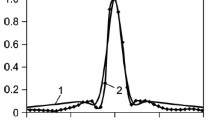The need for preliminary abrasive cleaning of gas pipelines to increase the efficiency of in-pipe diagnostics by magnetic longitudinal magnetization flaw detectors is evaluated. The method of abrasive cleaning of pipes and a tool that implements the method is presented. Results from pilot tests under conditions typical of Saratovorgdiagnostika company are presented.



Similar content being viewed by others
References
V. V. Lopatin, S. E. Popov, V. A. Kanaykin, and A. F. Matvienko, “The use of the electromagnetic acoustic method in practical monitoring of the state of the pipe of gas mains,” Defektoskopiya, No. 7, 3–11 (2008).
A. E. Gol’dshteyn, V. F. Bulgakov, and Kh.-M. Krening, “A method of vortex flow flaw detection of rods and pipes based on the use of a compound transducer with excitation of multi-frequency spatial components of the magnetic field,” Defektoskopiya, No. 11, 39–47 (2011).
M. A. Tamarkin, E. E. Tishchenko, Yu. V. Korol’kov, and O. A. Rozhnenko, “Increasing the efficiency of centrifugal-rotary treatment in an abrasive medium,” STIN, No. 2, 26–30 (2009).
V. Z. Zverovshchikov, A. E. Zverovshchikov, and E. A. Zverovshchikov, “Increasing the efficiency of volumetric centrifugal finishing-hardening treatment of parts in containers with planetary rotation,” Uprochn. Tekhnol. i Pokryt., No. 12, 3–7 (2007).
D. Arola, M. L. McCain, S. Kunaporn, and M. Ramulu, “Waterjet and abrasive waterjet surface treatment of titanium: a comparison of surface texture and residual stress,” Wear, 249, 943–950 (2002).
A. Ghobeity, D. Ciampini, and M. Papini, “An analytical model of the effect of particle size distribution on the surface profile evolution in abrasive jet micromachining,” J. Mater. Proc. Technol., 209, No. 20, 6067–6077 (2009).
A. S. Sevost’yanov, A. A. Luk’yanov, and I. N. Bobrovskii, “Contemporary state of studies in the area of deposition of microrelief in domestic science,” Theor. & Appl. Sci., No. 10, 82–84 (2014).
Author information
Authors and Affiliations
Corresponding author
Additional information
Translated from Khimicheskoe i Neftegazovoe Mashinostroenie, No. 8, pp. 29–32, August, 2016.
Rights and permissions
About this article
Cite this article
Sklyarov, I.A., Zakharov, O. & Kochetkov, A.V. Increasing the Efficiency of Diagnostics of Gas Pipelines Based on Preliminary Abrasive Cleaning. Chem Petrol Eng 52, 552–556 (2016). https://doi.org/10.1007/s10556-016-0230-5
Published:
Issue Date:
DOI: https://doi.org/10.1007/s10556-016-0230-5




